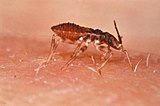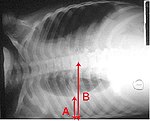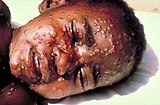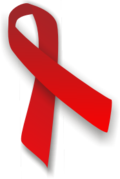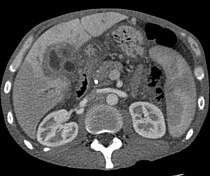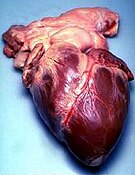Usage
- Add a new selected Article to the next available subpage.
- Update "max=" to new total for its {{Random portal component}} on the main page.
Selected Articles
Selected Article 1
Portal:Medicine/Selected Article/1
Al-Risalah al-Dhahabiah (Arabic: ٱلرِّسَالَة ٱلذَّهَبِيَّة, Arabic pronunciation: ['rɪsælætæ 'ðæhæ'biæ]; "The Golden Treatise") is a medical dissertation on health and remedies attributed to Ali ibn Musa al-Ridha (765–818), the eighth Imam of Shia. He wrote this dissertation in accordance with the demand of Ma'mun, the caliph of the time. It is revered as the most precious Islamic literature in the science of medicine, and was entitled "the golden treatise" as Ma'mun had ordered it written in gold ink. The chain of narrators is said to reach Muhammad ibn Jumhoor or al-Hassan ibn Muhammad al-Nawfali who is described as "highly esteemed and trustworthy" by al-Najjashi.
The treatise of Ali al-Ridha includes scientific branches such as Anatomy, Physiology, Chemistry and Pathology when medical science was still primitive. According to the treatise, one's health is determined by four humors of blood, yellow bile, black bile and phlegm, the suitable proportion of which maintains the health. The liver plays an important role in producing and maintaining the required proportions in the body. Ali al-Ridha describes the body as a kingdom whose king is the heart while the (blood) vessels, the limbs, and the brain are the laborers. The issue of the authorship and the transmission of the text has been critically analysed in the studies by Speziale (2004) and Speziale - Giurini (2009). (Full article...)
Selected Article 2
Portal:Medicine/Selected Article/2
Schizophrenia is a psychiatric diagnosis that describes a mental disorder characterized by abnormalities in the perception or expression of reality. It most commonly manifests as auditory hallucinations, paranoid or bizarre delusions, or disorganized speech and thinking with significant social or occupational dysfunction. Onset of symptoms typically occurs in young adulthood, with approximately 0.4–0.6% of the population affected. Diagnosis is based on the patient's self-reported experiences and observed behavior. No laboratory test for schizophrenia currently exists.
Studies suggest that genetics, early environment, neurobiology, psychological and social processes are important contributory factors; some recreational and prescription drugs appear to cause or worsen symptoms. Despite its etymology, schizophrenia is not the same as dissociative identity disorder, previously known as multiple personality disorder or split personality; in popular culture the two are often confused. Read more...
Selected Article 3
Portal:Medicine/Selected Article/3

Selected Article 4
Portal:Medicine/Selected Article/4
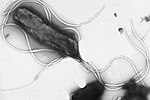
Helicobacter pylori is a bacterium that infects the mucus lining of the human stomach. Many peptic ulcers and some types of gastritis are caused by H. pylori infection, although most humans who are infected will never develop symptoms. This bacterium lives in the human stomach exclusively and is the only known organism that can thrive in that highly acidic environment. It is helix-shaped (hence the name helicobacter) and can literally screw itself into the stomach lining to colonize.
The bacterium was rediscovered in 1982 by two Australian scientists Robin Warren and Barry Marshall; they isolated the organisms from mucosal specimens from human stomachs and were the first to successfully culture them. In their original paper, Warren and Marshall contended that most stomach ulcers and gastritis were caused by colonization with this bacterium, not by stress or spicy food as had been assumed before.
(More...)
Selected Article 5
Portal:Medicine/Selected Article/5

Asthma is a disease of the human respiratory system where the airways narrow, often in response to a "trigger" such as exposure to an allergen, cold air, exercise, or emotional stress. This narrowing causes symptoms such as wheezing, shortness of breath, chest tightness, and coughing, which respond to bronchodilators. Between episodes, most patients feel fine.
The disorder is a chronic (reoccurring) inflammatory condition in which the airways develop increased responsiveness to various stimuli, characterized by bronchial hyper-responsiveness, inflammation, increased mucus production, and intermittent airway obstruction. The symptoms of asthma, which can range from mild to life-threatening, can usually be controlled with a combination of drugs and lifestyle changes.
The word asthma is derived from the Greek aazein, meaning "sharp breath." The word first appears in Homer's Iliad. Hippocrates was the first to use it in reference to the medical condition. Hippocrates thought that the spasms associated with asthma were more likely to occur in tailors, anglers, and metalworkers. Six centuries later, Galen wrote much about asthma, noting that it was caused by partial or complete bronchial obstruction. Moses Maimonides, an influential medieval rabbi, philosopher, and physician, wrote a treatise on asthma, describing its prevention, diagnosis, and treatment.
(More...)
Selected Article 6
Portal:Medicine/Selected Article/6
The cerebellum (Latin: "little brain") is a region of the brain that plays an important role in the integration of sensory perception and motor output. Many neural pathways link the cerebellum with the motor cortex—which sends information to the muscles causing them to move—and the spinocerebellar tract—which provides feedback on the position of the body in space (proprioception). The cerebellum integrates these pathways, using the constant feedback on body position to fine-tune motor movements.Because of this 'updating' function of the cerebellum, lesions within it are not so debilitating as to cause paralysis, but rather present as feedback deficits resulting in disorders in fine movement, equilibrium, posture, and motor learning. Initial observations by physiologists during the 18th century indicated that patients with cerebellar damage show problems with motor coordination and movement. Research into cerebellar function during the early to mid 19th century was done via lesion and ablation studies in animals. Research physiologists noted that such lesions led to animals with strange movements, awkward gait, and muscular weakness. These observations and studies led to the conclusion that the cerebellum was a motor control structure. However, modern research shows that the cerebellum has a broader role in a number of key cognitive functions, including attention and the processing of language, music, and other sensory temporal stimuli. (More...)
Selected Article 7
Portal:Medicine/Selected Article/7

β-Hydroxy β-methylbutyric acid (HMB) is a naturally produced substance in humans that is used as a dietary supplement. It is an ingredient in certain medical foods that are intended to promote wound healing and provide nutritional support for people with muscle wasting due to cancer or HIV/AIDS. In healthy adults, supplementation with HMB has been shown to reduce skeletal muscle damage from exercise, expedite recovery from exercise, and increase exercise-induced gains in muscle size, muscle strength, and lean body mass. Medical reviews and meta-analyses indicate that HMB supplementation also helps to preserve or increase lean body mass and muscle strength in individuals experiencing age-related muscle loss. HMB produces these effects in part by stimulating protein production and inhibiting protein breakdown in muscle tissue. Pharmacologically active concentrations of the compound in blood plasma and muscle can only be achieved by supplementation with HMB. (More...)
Selected Article 8
Portal:Medicine/Selected Article/8
Chagas disease, also known as American trypanosomiasis, is a tropical parasitic disease caused by Trypanosoma cruzi. It is spread mostly by insects in the subfamily Triatominae, known as "kissing bugs". The symptoms change over the course of the infection. In the early stage, symptoms are typically either not present or mild, and may include fever, swollen lymph nodes, headaches, or swelling at the site of the bite. After four to eight weeks, untreated individuals enter the chronic phase of disease, which in most cases does not result in further symptoms. Up to 45% of people with chronic infections develop heart disease 10–30 years after the initial illness, which can lead to heart failure. Digestive complications, including an enlarged esophagus or an enlarged colon, may also occur in up to 21% of people, and up to 10% of people may experience nerve damage.
T. cruzi is commonly spread to humans and other mammals by the kissing bug's bite wound and infected feces. The disease may also be spread through blood transfusion, organ transplantation, consuming food or drink contaminated with the parasites, and vertical transmission (from a mother to her baby). Diagnosis of early disease is by finding the parasite in the blood using a microscope or detecting its DNA by polymerase chain reaction. Chronic disease is diagnosed by finding antibodies for T. cruzi in the blood. (Full article...)
Selected Article 9
Portal:Medicine/Selected Article/9
Metabolism is the set of chemical reactions that occur in living organisms in order to maintain life. These processes allow organisms to grow and reproduce, maintain their structures, and respond to their environments. Metabolism is usually divided into two categories. Catabolism breaks down large molecules, for example to harvest energy in cellular respiration. Anabolism, on the other hand, uses energy to construct components of cells such as proteins and nucleic acids.
The chemical reactions of metabolism are organized into metabolic pathways, in which one chemical is transformed into another by a sequence of enzymes. Enzymes are crucial to metabolism because they allow organisms to drive desirable but thermodynamically unfavorable reactions by coupling them to favorable ones. Enzymes also allow the regulation of metabolic pathways in response to changes in the cell's environment or signals from other cells.
(More...)
Selected Article 10
Portal:Medicine/Selected Article/10
Influenza, commonly known as flu, is an infectious disease of birds and mammals caused by RNA viruses of the family Orthomyxoviridae (the influenza viruses). The name influenza comes from the Italian: influenza, meaning "influence", (Latin: influentia). In humans, common symptoms of the disease are fever, sore throat, muscle pains, severe headache, coughing, weakness and general discomfort. In more serious cases, influenza causes pneumonia, which can be fatal, particularly in young children and the elderly. Although it is sometimes confused with the common cold, influenza is a much more severe disease and is caused by a different type of virus. Influenza can produce nausea and vomiting, especially in children, but these symptoms are more characteristic of the unrelated gastroenteritis, which is sometimes called "stomach flu" or "24-hour flu."
(More...)
Selected Article 11
Portal:Medicine/Selected Article/11
Buruli ulcer (/bəˈruːli/) is an infectious disease characterized by the development of painless open wounds. The disease is limited to certain areas of the world, most cases occurring in Sub-Saharan Africa and Australia. The first sign of infection is a small painless nodule or area of swelling, typically on the arms or legs. The nodule grows larger over days to weeks, eventually forming an open ulcer. Deep ulcers can cause scarring of muscles and tendons, resulting in permanent disability.
Buruli ulcer is caused by skin infection with bacteria called Mycobacterium ulcerans. The mechanism by which M. ulcerans is transmitted from the environment to humans is not known, but may involve the bite of an aquatic insect or the infection of open wounds. Once in the skin, M. ulcerans grows and releases the toxin mycolactone, which blocks the normal function of cells, resulting in tissue death and immune suppression at the site of the ulcer. (Full article...)
Selected Article 12
Portal:Medicine/Selected Article/12
Pneumonia is an illness of the lungs and respiratory system in which the alveoli (microscopic air-filled sacs of the lung responsible for absorbing oxygen from the atmosphere) become inflamed and flooded with fluid. Pneumonia can result from a variety of causes, including infection with bacteria, viruses, fungi, or parasites. Pneumonia may also occur from chemical or physical injury to the lungs, or indirectly due to another medical illness, such as lung cancer or alcohol abuse.
Typical symptoms associated with pneumonia include cough, chest pain, fever, and difficulty breathing. Diagnostic tools include x-rays and examination of the sputum. Treatment depends on the cause of pneumonia; bacterial pneumonia is treated with antibiotics.
Pneumonia is a common illness, occurs in all age groups, and is a leading cause of death among the elderly and people who are chronically ill. Vaccines to prevent certain types of pneumonia are available. The prognosis for an individual depends on the type of pneumonia, the appropriate treatment, any complications, and the person's underlying health. (More...)
Selected Article 13
Portal:Medicine/Selected Article/13
The menstrual cycle is a series of natural changes in hormone production and the structures of the uterus and ovaries of the female reproductive system that makes pregnancy possible. The ovarian cycle controls the production and release of eggs and the cyclic release of estrogen and progesterone. The uterine cycle governs the preparation and maintenance of the lining of the uterus (womb) to receive an embryo. These cycles are concurrent and coordinated, normally last between 21 and 35 days, with a median length of 28 days, and continue for about 30–45 years.
Naturally occurring hormones drive the cycles; the cyclical rise and fall of the follicle stimulating hormone prompts the production and growth of oocytes (immature egg cells). The hormone estrogen stimulates the uterus lining (endometrium) to thicken to accommodate an embryo should fertilization occur. The blood supply of the thickened lining provides nutrients to a successfully implanted embryo. If implantation does not occur, the lining breaks down and blood is released. Triggered by falling progesterone levels, menstruation (a "period", in common parlance) is the cyclical shedding of the lining, and is a sign that pregnancy has not occurred. (Full article...)
Selected Article 14
Portal:Medicine/Selected Article/14
Smallpox is an acute infectious disease unique to humans, caused by either of two virus variants named Variola major and Variola minor. Also known by the Latin names Variola or Variola vera; a derivative of the Latin varius, meaning spotted, or varus, meaning "pimple". The term "smallpox" was first used in Europe in the 15th century to distinguish variola from the great pox (syphilis).
Smallpox localizes in small blood vessels of the skin and in the mouth and throat. In the skin, this results in the characteristic maculopapular rash, which evolves into raised vesicles, then into fluid-filled pustules. V. major produces a more serious disease and has an overall mortality rate of 30–35%. V. minor (also known as alastrim, cottonpox, milkpox, whitepox, and Cuban itch) causes a milder form of disease which kills ~1% of its victims.
(More...)
Selected Article 15
Portal:Medicine/Selected Article/15
Acquired immunodeficiency syndrome or acquired immune deficiency syndrome (AIDS or aids) is a collection of symptoms and infections in humans resulting from the specific damage to the immune system caused by infection with the human immunodeficiency virus (HIV). The late stage of the condition leaves individuals prone to opportunistic infections and tumors. Although treatments for AIDS and HIV exist to slow the virus's progression, there is no known cure. HIV is transmitted through direct contact of a mucous membrane or the bloodstream with a bodily fluid containing HIV, such as blood, semen, vaginal fluid, preseminal fluid, and breast milk. This transmission can come in the form of anal, vaginal or oral sex, blood transfusion, contaminated needles, exchange between mother and baby during pregnancy, childbirth, or breastfeeding, or other exposure to one of the above bodily fluids. Most researchers believe that HIV originated in sub-Saharan Africa during the twentieth century; it is now a pandemic, with an estimated 38.6 million people now living with the disease worldwide. (More...)
Selected Article 16
Portal:Medicine/Selected Article/16
A complete blood count (CBC), also known as a full blood count (FBC), is a set of medical laboratory tests that provide information about the cells in a person's blood. The CBC indicates the counts of white blood cells, red blood cells and platelets, the concentration of hemoglobin, and the hematocrit (the volume percentage of red blood cells). The red blood cell indices, which indicate the average size and hemoglobin content of red blood cells, are also reported, and a white blood cell differential, which counts the different types of white blood cells, may be included.
The CBC is often carried out as part of a medical assessment and can be used to monitor health or diagnose diseases. The results are interpreted by comparing them to reference ranges, which vary with sex and age. Conditions like anemia and thrombocytopenia are defined by abnormal complete blood count results. The red blood cell indices can provide information about the cause of a person's anemia such as iron deficiency and vitamin B12 deficiency, and the results of the white blood cell differential can help to diagnose viral, bacterial and parasitic infections and blood disorders like leukemia. Not all results falling outside of the reference range require medical intervention. (Full article...)
Selected Article 17
Portal:Medicine/Selected Article/17
Cholangiocarcinoma is a cancer of the bile ducts, which drain bile from the liver into the small intestine. It is a relatively rare cancer, with an annual incidence of 1–2 cases per 100,000 in the Western world, but rates of cholangiocarcinoma have been rising worldwide over the past several decades. Risk factors for cholangiocarcinoma include primary sclerosing cholangitis (an inflammatory disease of the bile ducts), congenital liver malformations, infection with the parasitic liver flukes Opisthorchis viverrini or Clonorchis sinensis, and exposure to Thorotrast (thorium dioxide), a chemical previously used in medical imaging. The symptoms of cholangiocarcinoma include jaundice, weight loss, and sometimes generalized itching. The disease is diagnosed through a combination of blood tests, imaging, endoscopy, and sometimes surgical exploration.
(More...)
Selected Article 18
Portal:Medicine/Selected Article/18
An ambulance is a vehicle for transporting people to, from or between places of treatment for an illness or injury. In the modern context it is also the vehicle commonly used to bring medical care to patients outside of the hospital and, when appropriate, to transport the patient to hospital for follow-up care and further testing. There is also a modified form of the ambulance used in several jurisdictions that only carries one member of ambulance crew to the scene to provide care but is not used to transport the patient. In these cases a patient who requires transportation to hospital will require a patient carrying ambulance to attend in addition to the fast responder. The term ambulance comes from the Latin word ambulare, meaning to walk or move about which is a reference to early medical care where patients were moved by lifting or wheeling. The word is most commonly associated with the land-based, motorized emergency vehicles that administer emergency care to those with acute illnesses or injuries, hereafter known as emergency ambulances. These are usually fitted with flashing warning lights and sirens to facilitate their movement through traffic. (More...)
Selected Article 19
Portal:Medicine/Selected Article/19
DNA repair refers to a collection of processes by which a cell identifies and corrects damage to the DNA molecules that encode its genome. In human cells, both normal metabolic activities and environmental factors such as UV light can cause DNA damage, resulting in as many as 1 million individual molecular lesions per cell per day. Many of these lesions cause structural damage to the DNA molecule and can alter or eliminate the cell's ability to transcribe the gene that the affected DNA encodes. Other lesions induce potentially harmful mutations in the cell's genome, which will affect the survival of its daughter cells after it undergoes mitosis. Consequently, the DNA repair process must be constantly active so it can respond rapidly to any damage in the DNA structure. The DNA repair ability of a cell is vital to the integrity of its genome and thus to its normal functioning and that of the organism. Many genes that were initially shown to influence lifespan have turned out to be involved in DNA damage repair and protection. Failure to correct molecular lesions in cells that form gametes can introduce mutations into the genomes of the offspring and thus influence the rate of evolution. (More...)
Selected Article 20
Portal:Medicine/Selected Article/20
Barbara McClintock (June 16, 1902 – September 2, 1992) was a pioneering American scientist and one of the world's most distinguished cytogeneticists. McClintock received her PhD in botany from Cornell University in 1927, where she was a leader in the development of maize cytogenetics. The field remained the focus of her research for the rest of her career. From the late 1920s, McClintock studied chromosomes and how they change during reproduction in maize. Her work was groundbreaking: she developed the technique to visualize maize chromosomes and used microscopic analysis to demonstrate many fundamental genetic ideas, including genetic recombination by crossing-over during meiosis—a mechanism by which chromosomes exchange information. She produced the first genetic map for maize, linking regions of the chromosome with physical traits, and she demonstrated the role of the telomere and centromere, regions of the chromosome that are important in the conservation of genetic information. She was recognized amongst the best in the field, awarded prestigious fellowships and elected a member of the National Academy of Sciences in 1944. (More...)
Selected Article 21
Portal:Medicine/Selected Article/21
Tourette syndrome is an inherited neurological disorder with onset in childhood, characterized by the presence of multiple physical (motor) tics and at least one vocal (phonic) tic; these tics usually wax and wane. Tourette's is defined as part of a spectrum of tic disorders, which includes transient and chronic tics. Tourette's was once considered a rare and bizarre syndrome, most often associated with the exclamation of obscene words or socially inappropriate and derogatory remarks (coprolalia). However, this symptom is present in fewer than 15% of people with Tourette's. It is no longer considered a rare condition, but it may not always be correctly identified because of the wide range of severity, with most cases classified as mild. Genetic and environmental factors each play a role in the etiology of Tourette's, but the exact causes are unknown. (More...)
Selected Article 22
Portal:Medicine/Selected Article/22
Acute myeloid leukemia (AML), also known as acute myelogenous leukemia, is a cancer of the myeloid line of white blood cells, characterized by the rapid proliferation of abnormal cells which accumulate in the bone marrow and interfere with the production of normal blood cells. AML is the most common acute leukemia affecting adults, and its incidence increases with age. While AML is a relatively rare disease overall, accounting for approximately 1.2% of cancer deaths in the United States, its incidence is expected to increase as the population ages. The symptoms of AML are caused by replacement of normal bone marrow with leukemic cells, resulting in a drop in red blood cells, platelets, and normal white blood cells. While a number of risk factors for AML have been elucidated, the specific cause of AML remains unclear. As an acute leukemia, AML progresses rapidly and is typically fatal in weeks to months if untreated. Acute myeloid leukemia is a potentially curable disease; however, only a minority of patients are cured with current therapy. AML is treated initially with chemotherapy aimed at inducing a remission; some patients may go on to receive a hematopoietic stem cell transplant. (More...)
Selected Article 23
Portal:Medicine/Selected Article/23
Down syndrome or trisomy 21 (British Down's syndrome) is a genetic condition resulting from the presence of all or part of an extra 21st chromosome. Down syndrome is characterized by a combination of major and minor abnormalities of body structure and function. Among features present in nearly all cases are impairment of learning and physical growth, and a recognizable facial appearance usually identified at birth. It is named after John Langdon Down, the British doctor who first described it in 1866. Individuals with Down syndrome have lower than average cognitive ability, normally ranging from mild to moderate retardation. Some individuals may have average intelligence overall, but will generally have some amount of developmental disability, such as a tendency toward concrete thinking or naïveté. There is also a small number of individuals with Down syndrome with severe to profound mental retardation. The incidence of Down syndrome is estimated at 1 per 800 to 1 per 1000 births.(More...)
Selected Article 24
Portal:Medicine/Selected Article/24
Dementia with Lewy bodies (DLB) is a type of dementia characterized by changes in sleep, behavior, cognition, movement, and regulation of automatic bodily functions. Memory loss is not always an early symptom. The disease worsens over time and is usually diagnosed when cognitive impairment interferes with normal daily functioning. Together with Parkinson's disease dementia, DLB is one of the two Lewy body dementias. It is a common form of dementia, but the prevalence is not known accurately and many diagnoses are missed. The disease was first described on autopsy by Kenji Kosaka in 1976, and he named the condition several years later.
REM sleep behavior disorder (RBD)—in which people lose the muscle paralysis (atonia) that normally occurs during REM sleep and act out their dreams—is a core feature. RBD may appear years or decades before other symptoms. Other core features are visual hallucinations, marked fluctuations in attention or alertness, and parkinsonism (slowness of movement, trouble walking, or rigidity). A presumptive diagnosis can be made if several disease features or biomarkers are present; the diagnostic workup may include blood tests, neuropsychological tests, imaging, and sleep studies. A definitive diagnosis usually requires an autopsy. (Full article...)
Selected Article 25
Portal:Medicine/Selected Article/25
Henrietta Lacks (born Loretta Pleasant; August 1, 1920 – October 4, 1951) was an African-American woman whose cancer cells are the source of the HeLa cell line, the first immortalized human cell line and one of the most important cell lines in medical research. An immortalized cell line reproduces indefinitely under specific conditions, and the HeLa cell line continues to be a source of invaluable medical data to the present day.
Lacks was the unwitting source of these cells from a tumor biopsied during treatment for cervical cancer at Johns Hopkins Hospital in Baltimore, Maryland, in 1951. These cells were then cultured by George Otto Gey, who created the cell line known as HeLa, which is still used for medical research. As was then the practice, no consent was required to culture the cells obtained from Lacks's treatment. Neither she nor her family were compensated for the extraction or use of the HeLa cells. (Full article...)
Selected Article 26
Portal:Medicine/Selected Article/26
The 1918 flu pandemic was an influenza pandemic between 1918 and 1920 caused by an unusually severe and deadly strain of the subtype H1N1 of the species Influenza A virus. By far the most destructive influenza pandemic in history, it killed some 50 million to 100 million people worldwide (2.5 – 5% of the human population) in just 18 months, dwarfing the simultaneous bloodshed due to World War I. Furthermore, many of its victims were healthy young adults, in contrast to most influenza outbreaks which predominantly affect juvenile, elderly, or otherwise weakened patients.
Despite not having originated in Spain, the Allies of World War I came to call it the Spanish Flu. This was mainly because the pandemic received greater press attention in Spain than in the rest of the world, as Spain was not involved in the war and had not imposed wartime censorship. (More...)
Selected Article 27
Portal:Medicine/Selected Article/27
The heart is a muscular organ in most animals, which pumps blood through the blood vessels of the circulatory system. Blood provides the body with oxygen and nutrients, as well as assists in the removal of metabolic wastes. In humans, the heart is located between the lungs, in the middle compartment of the chest. In humans, other mammals, and birds, the heart is divided into four chambers: upper left and right atria; and lower left and right ventricles. The heart pumps blood with a rhythm determined by a group of pacemaking cells in the sinoatrial node. These generate a current that causes contraction of the heart, traveling through the atrioventricular node and along the conduction system of the heart. The heart receives blood low in oxygen from the systemic circulation, which enters the right atrium from the superior and inferior venae cavae and passes to the right ventricle. From here it is pumped into the pulmonary circulation, through the lungs where it receives oxygen and gives off carbon dioxide. Oxygenated blood then returns to the left atrium, passes through the left ventricle and is pumped out through the aorta to the systemic circulation−where the oxygen is used and metabolized to carbon dioxide. The heart beats at a resting rate close to 72 beats per minute. (More...)
Selected Article 28
Portal:Medicine/Selected Article/28
Crohn's disease (also known as regional enteritis) is a chronic, episodic, inflammatory condition of the gastrointestinal tract characterized by transmural inflammation (affecting the entire wall of the involved bowel) and skip lesions (areas of inflammation with areas of normal lining in between). Crohn's disease is a type of inflammatory bowel disease (IBD) and may sometimes affect any part of the gastrointestinal tract from mouth to anus; as a result, the symptoms of Crohn's disease can vary between affected individuals. The main gastrointestinal symptoms are abdominal pain, diarrhea, which may be bloody, and weight loss. Crohn's disease can also cause complications outside of the gastrointestinal tract such as skin rashes, arthritis, and inflammation of the eye. (More...)
Selected Article 29
Portal:Medicine/Selected Article/29
The 2007 Bernard Matthews H5N1 outbreak was an occurrence of avian flu in England that began on January 30, 2007. The infection was caused by the H5N1 subtype of the Influenza A virus and occurred at one of Bernard Matthews' farms in Holton in Suffolk. A range of precautions were instituted including a large cull of turkeys, the imposition of segregation zones, and a disinfection programme for the plant. Though the cause of the outbreak was not determined, Bernard Matthews regularly transports turkeys and turkey products between the UK and its plant in Hungary, and the H5N1 bird flu strains found in Hungary and Britain are effectively genetically identical. (More...)
Selected Article 30
Portal:Medicine/Selected Article/30
Cholangiocarcinoma is a cancer of the bile ducts, which drain bile from the liver into the small intestine. It is a relatively rare cancer, with an annual incidence of 1–2 cases per 100,000 in the Western world, but rates of cholangiocarcinoma have been rising worldwide over the past several decades. Risk factors for cholangiocarcinoma include primary sclerosing cholangitis (an inflammatory disease of the bile ducts), congenital liver malformations, infection with the parasitic liver flukes Opisthorchis viverrini or Clonorchis sinensis, and exposure to Thorotrast (thorium dioxide), a chemical previously used in medical imaging. The symptoms of cholangiocarcinoma include jaundice, weight loss, and sometimes generalized itching. The disease is diagnosed through a combination of blood tests, imaging, endoscopy, and sometimes surgical exploration. Surgery is the only potentially curative treatment, but most patients have advanced and inoperable disease at the time of diagnosis. After surgery, adjuvant chemotherapy or radiation therapy may be given to increase the chances of cure. Patients with advanced and inoperable cholangiocarcinoma are generally treated with chemotherapy and palliative care measures. Areas of ongoing medical research in cholangiocarcinoma include the use of newer targeted therapies (such as erlotinib) and the use of photodynamic therapy. (More...)
Selected Article 31
Portal:Medicine/Selected Article/31

Coeliac disease or celiac disease is an autoimmune disorder of the small bowel that occurs in genetically predisposed individuals in all age groups after early infancy. Symptoms may include diarrhoea, failure to thrive (in children) and fatigue, but these may be absent and associated symptoms in all other organ systems have been described. It affects approximately 1% of Caucasian populations, though it is significantly underdiagnosed. A growing portion of diagnoses are being made in asymptomatic persons as a result of increasing screening. Coeliac disease is caused by a reaction to gliadin, a gluten protein found in wheat (and similar proteins of the tribe Triticeae which includes other cultivars such as barley and rye). Upon exposure to gliadin, the enzyme tissue transglutaminase modifies the protein, and the immune system cross-reacts with the bowel tissue, causing an inflammatory reaction. That leads to flattening of the lining of the small intestine, which interferes with the absorption of nutrients. The only effective treatment is a lifelong gluten-free diet. (More...)
Selected Article 32
Portal:Medicine/Selected Article/32
Doxorubicin (trade name Adriamycin) or hydroxyldaunorubicin is a DNA-interacting drug widely used in chemotherapy. It is an anthracycline antibiotic and structurely closely related to daunomycin, and also intercalates DNA. It is commonly used in the treatment of a wide range of cancers. The drug is administered by injection, and may be sold under the brand names Adriamycin PFS, Adriamycin RDF, or Rubex. Doxil is a liposome-encapsulated dosage form of doxorubicin made by Ben Venue Laboratories for Johnson & Johnson. The main benefits of this form are a reduction in cardiotoxicity. (More...)
Selected Article 33
Portal:Medicine/Selected Article/33

Lung cancer is a disease of uncontrolled cell growth in tissues of the lung. This may lead to metastasis, invasion of adjacent tissue and infiltration beyond the lungs. Lung cancer, the most common cause of cancer-related death in men and the second most common in women, is responsible for 1.3 million deaths worldwide annually. The most common symptoms are shortness of breath, coughing (including coughing up blood), and weight loss. The main types of lung cancer are small cell lung carcinoma and non-small cell lung carcinoma. This distinction is important because the treatment varies; non-small cell lung carcinoma (NSCLC) is sometimes treated with surgery, while small cell lung carcinoma (SCLC) usually responds better to chemotherapy. The most common cause of lung cancer is exposure to tobacco smoke. The occurrence of lung cancer in non-smokers, who account for fewer than 10% of cases, appears to be due to a combination of genetic factors. Radon gas, asbestos, and air pollution may also contribute to lung cancer. Treatment and prognosis depend upon the histological type of cancer, the stage (degree of spread), and the patient's performance status. Possible treatments include surgery, chemotherapy, and radiotherapy. With treatment, the five-year survival rate is 14%. (More...)
Selected Article 34
Portal:Medicine/Selected Article/34
The genetic code is the set of rules by which information encoded in genetic material (DNA or RNA sequences) is translated into proteins (amino acid sequences) by living cells. Specifically, the code defines a mapping between tri-nucleotide sequences called codons and amino acids; every triplet of nucleotides in a nucleic acid sequence specifies a single amino acid. Because the vast majority of genes are encoded with exactly the same code (see #RNA codon table), this particular code is often referred to as the canonical or standard genetic code, or simply the genetic code, though in fact there are many variant codes (thus, the canonical genetic code is not universal). For example, in humans, protein synthesis in mitochondria relies on a genetic code that varies from the canonical code. (More...)
Selected Article 35
Portal:Medicine/Selected Article/35
Metformin (INN; trade names Glucophage, Diabex, Diaformin, Fortamet, Riomet, Glumetza and others) is an anti-diabetic drug from the biguanide class of oral antihyperglycemic agents. Other biguanides include the withdrawn agents phenformin and buformin. Metformin is the most popular anti-diabetic drug in the United States and one of the most prescribed drugs overall, with nearly 35 million prescriptions filled in 2006 for generic metformin alone. The biguanide class of anti-diabetic drugs originates from the French lilac (Galega officinalis), a plant known for several centuries to reduce the symptoms of diabetes mellitus. (More...)
Selected Article 36
Portal:Medicine/Selected Article/36
Autism is a brain development disorder that shows symptoms before a child is three years old and has a steady course with no remission. Its characteristic signs are impairments in social interaction and communication, as well as restricted and repetitive behavior. These characteristics distinguish autism from milder pervasive developmental disorders (PDD) or autism spectrum disorders (ASD), and reflect Leo Kanner's first descriptions of autism, which emphasized "autistic aloneness" and "insistence on sameness". Heritability contributes about 90% of the risk of a child developing autism, but the genetics of autism are complex and typically it is unclear which genes are responsible. In rare cases, autism is strongly associated with agents that cause birth defects. Many other causes have been proposed, such as exposure of children to vaccines; these proposals are controversial and the vaccine hypotheses have no convincing scientific evidence. (More...)


